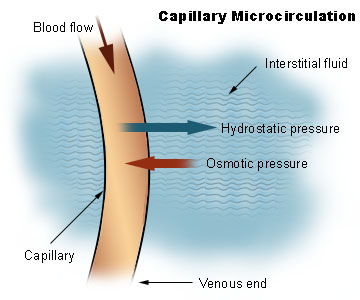Capillary facts for kids

A capillary is a blood vessel. It does not have the muscular/elastic tissue of other blood vessels. It has a single celled wall to help substances be transported through organisms. Capillaries are small, and smaller than any other blood vessels. They are about 5-10 μms big, which connect arteries and venules, and enable the moving of water, oxygen, carbon dioxide, as well as many other nutrients and waste chemicals between blood and surrounding tissues.
Anatomy
Blood moves from the heart to arteries, which branch and narrow into smaller arteries, and then branch more into capillaries. After oxygen has been moved to the tissue, capillaries join and widen to become small veins and then widen more to become veins, which return blood to the heart.
The "capillary bed" is the network of capillaries supplying an organ. The more metabolically active the cells, the more capillaries it will require to supply nutrients and carry away waste products.
Special arteries connect between arterioles and venules and are important in bypassing the flow of blood through the capillaries. True capillaries come from mainly from metarterioles and provide movement between cells and the circulation. The width of 8 μm forces the red blood cells to partly fold into bullet-like shapes in order to bypass them in single file.
Precapillary muscles are rings of smooth muscles at the start of true capillaries that handle blood flow into true capillaries and control blood flow through a body part or area.
Physiology
The capillary wall is a one-layer tissue so thin that gas and other items such as oxygen, water, proteins and fats can pass through them driven by pressure differences. Waste items such as carbon dioxide and urea can move back into the blood to be carried away for removal from the body.
The capillary bed usually moves no more than 25% of the amount of blood it could contain, although this amount can be increased through auto regulation by making the smooth muscle relax in the arterioles that lead to the capillary bed as well as metarterioles making themselves smaller.
The capillaries do not have this smooth muscle in their own wall, and so any change in their width is passive. Any signaling molecules they release (such as endothelin for constriction and nitric oxide for dilation) act on the smooth muscle cells in the walls of nearby, larger vessels, e.g. arterioles.
Capillary's ability to move items can be increased by the release of certain cytokines, such as in an the body defending itself from germs.
Related pages
- Alveolar-capillary barrier
- Blood brain barrier
- Capillary action
- Hagen-Poiseuille equation
- Histology at BU 00903loa
Images for kids
See also
 In Spanish: Capilar sanguíneo para niños
In Spanish: Capilar sanguíneo para niños






